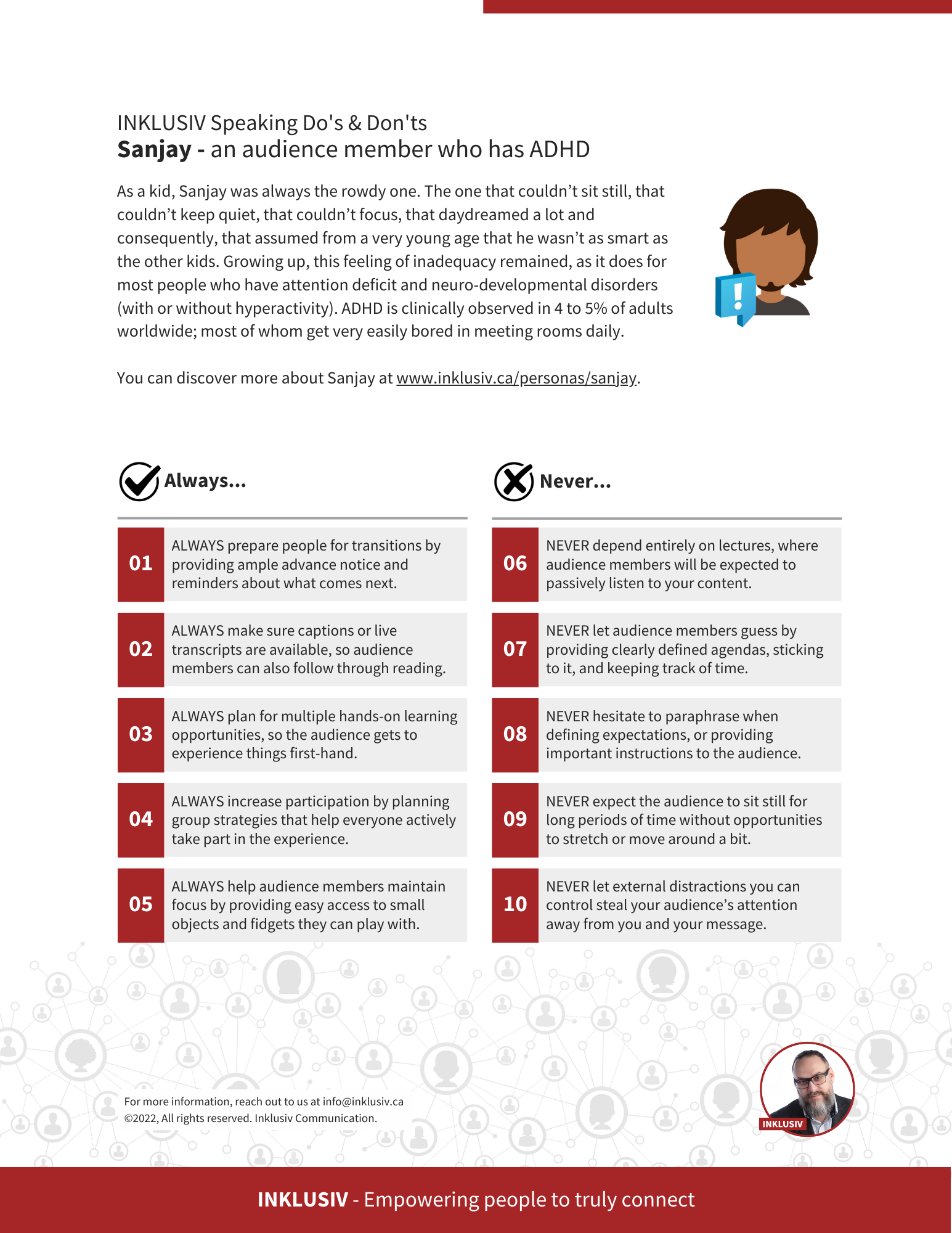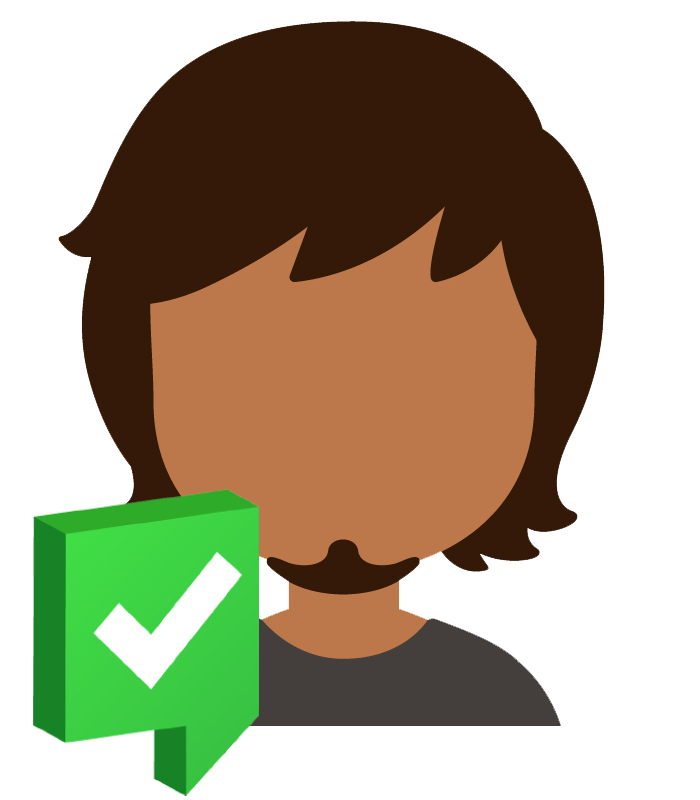Introducing Sanjay (he/him), an audience member who has ADHD
Attention Deficit Hyperactivity Disorder (ADHD or ADD) is a neurological disorder that affects an estimated 4.4 percent of U.S. adults, and is more commonly diagnosed in men (5.4%) than in women (3.2%), though scientists believe ADHD is significantly under diagnosed in adults. “For me, as well as with most adults, ADHD is characterized by a persistent pattern of inattention, hyperactivity, and/or impulsivity that interferes with and impacts work, home life, and relationships,” Sanjay explains.
“As a social media content creator and influencer, I fully embraced my condition a few years ago, when I decided to place it front and center, and turn it into my competitive advantage.” His award-winning podcast ‘Living my best life with ADHD’, attracts over half a million followers each month over Twitch and YouTube, and has allowed him to very successfully monetize his hobby. “On my show, I regularly tell stories and jokes about my challenges with time management, memory, organization, emotional regulation, and more. It’s really working for me,” he adds.
In a world where people’s attention spans seem to be getting shorter by the minute, where everyone is constantly distracted by notifications from their smart phones and tablets, where trends show a rise in rates of ADHD diagnoses among U.S. adults in the last decade, Sanjay’s content is a breath of fresh air for a lot of people, including many adults with ADHD who may never receive a diagnosis in their lifetimes.
“Keeping my ADHD in check can prove very difficult at times, especially when I attend live, in-person or virtual events. If the speakers don’t find a way to quickly pull me in, by purposefully engaging the audience in a more participatory experience, I’ll inevitably be drawn to my phone within minutes,” he adds. “I’ll be much more interested in taking notes about how I could turn this awful presentation into the topic of my next podcast episode, than trying to fight the incessant waves of boredom that wash over me from the horrible presentation.”

“Unclear instructions, unnecessary distractions, and long lectures are surefire ways for a speaker to completely lose my attention in a matter of minutes.”
Sanjay’s Do’s and Don’ts Poster

Inclusive Speaking Do’s & Don’ts – Sanjay
As speaking professionals, we pride ourselves on mastering the ability to engage our audience and change their lives with our thoughts and ideas. But just how inclusive are you really, when it comes to touching the hearts and minds of audience members like Sanjay who have Attention Deficit Hyperactivity Disorders? Below are some of the basic Do’s & Don’ts that speakers should always keep in mind, when communicating their message to audience members who have ADHD, and will struggle with focusing and perceiving information the way neurotypical audience members otherwise do.
As a speaking professional trying to engage someone like Sanjay, always…
01. Prepare people for transitions by providing ample advance notice and reminders about what comes next

Do you systematically prepare people for transitions by providing ample advance notice and reminders about what comes next? To offer a truly inclusive experience, it’s important to start by creating a “safe nest” where everyone feels comfortable opening up and can predict what will come next. It can be incredibly unsettling for someone like Sanjay to suddenly find himself caught off guard by unexpected, or unforeseen requests, like being put on the spot or asked to do something without advance notice. In environments where such things can happen, anxiety and stress can really build up for audience members with ADHD who try to concentrate, to the point where the experience can become a seemingly impenetrable wall of awful. Always have a benevolent approach where expectations are clearly announced ahead of time, so audience members aren’t stumped by requests or expectations that could make them feel uneasy.
02. Make sure captions or live transcripts are available, so audience members can also follow through reading

Do you systematically make sure captions or live transcripts are available, so audience members can also follow through reading? It would be easy to assume that captions and transcripts only benefit audience members who are deaf or hard of hearing! For someone like Sanjay, dealing with attention deficit and hyperactivity disorder (ADHD), captions and transcripts provide his brain something to circle back to when he gets distracted. And distractions are bound to happen! Captions and transcripts also tremendously help Sanjay soak in information on low energy days when listening is hard. For audience members who have ADHD, the act of listening can sometimes prove to be more challenging than they’d like to admit. In situations where keeping the focus is harder, being able to read captions as they’re listening to the speaker can make a world of difference, whether it’s on a virtual platform or in the conference room.
03. Plan for multiple hands-on learning opportunities, so the audience gets to experience things first-hand

Do you systematically plan for multiple hands-on learning opportunities, so the audience gets to experience things first-hand? There’s a reason why movies often depict bored and jaded professors droning on and on while students fight off the urge to fall asleep. Audience members are just begging to feel engaged in your content, and “death by PowerPoint” is not the way to do it! Instead of simply showing audience members like Sanjay how to do something or telling them how it should be done, always make sure that ample time is also factored in to let audience members who have ADHD, as well as kinesthetic learners, figure out how they can experience the thing for themselves. What this means is, to truly offer equitable ways of learning a trade, a tool, or a skill during a workshop, you must factor in enough hands-on time to appeal to all learning styles.
04. Increase participation by planning group strategies that help everyone actively take part in the experience

Do you systematically increase participation by planning group strategies that help everyone actively take part in the experience? One of the secrets to an inclusive experience in live, in-person, or virtual events is to diversify the ways through which participants get to learn and interact with the content and one another. One-on-one communication and individual exercises will only get you so far in terms of keeping the interest of someone like Sanjay. At some point, most audience members will want to interact with other participants to brainstorm about ideas, test out their own understanding, and socialize about the topic at hand. To help audience members with ADHD feel more connected and engaged to what is going on, it’s often best to allow for moments where participants will get to come together as a group or subgroup and proactively hash out different ideas or challenges together.
05. Help audience members maintain focus by providing easy access to small objects and fidgets they can play with

Do you systematically help audience members maintain focus by providing easy access to small objects and fidgets they can play with? 2013 research published on Frontiers [28] suggests that purposeful fidgeting can increase the neurotransmitters that control attention span, helping improve focus in the process, and making sitting or staying still for long periods more tolerable for audience members with ADHD. The findings from the research also suggest that fidgeting provides physiological stimulation to bring attention and energy to a level that allows people’s minds to better focus on the task at hand. For audience members like Sanjay, fidgeting makes all the difference in the world. Whenever possible, work with event organizers to bring small objects into the sessions, like stretchy bands, tactile Koosh balls, pens to twirl through fingers, or paper pads for doodling or jotting down any thoughts, questions, or ideas that pop into people’s heads during the presentation.
As a speaking professional trying to engage someone like Sanjay, never…
06. Depend entirely on lectures where audience members will be expected to passively listen to your content

Do you systematically avoid depending entirely on lectures where audience members will be expected to passively listen to your content? People learn in a myriad of different ways, and someone like Sanjay, who self-identifies as having ADHD, definitely learns best in ways that are very different from most other people. Yes, being shown and told how to do something will work to a certain extent, but the real learning will often only occur when Sanjay gets a chance to try the thing out for himself. Like kinesthetic learners who prefer to learn by doing, Sanjay and other audience members with ADHD will often run a higher risk of disengaging if they’re not directly involved in the action. By covering all three approaches (showing, telling, AND practicing), you are creating an environment where everyone can feel equally engaged and empowered to learn just as efficiently as anybody else.
07. Let audience members guess by providing clearly defined agendas, sticking to it, and keeping track of time

Do you systematically avoid letting audience members guess by providing clearly defined agendas, sticking to it, and keeping track of time? Having an idea of how to solve a problem and what the finished task would look like helps audience members better understand what they’re aiming for. However, when it comes to people who have ADHD, research suggests that they tend to generally experience more trouble with motivation. This is because audience members with ADHD can’t visualize the end goals as easily, making it harder for them to figure out the steps in between. To help someone like Sanjay remain engaged, always be very clear with the agenda, what will be covered, and the order in which steps will be covered, to better support visuospatial memory and impaired time perceptions. Consider such challenges when planning seminars, assessments, and lectures, or agreed timed goals and other deadlines.
08. Hesitate to paraphrase when defining expectations or providing important instructions to the audience

Do you systematically avoid hesitating to paraphrase when defining expectations or providing important instructions to the audience? No matter how much energy you put into explaining instructions or expectations before a breakout or group activity takes place, there will always be a handful of people in the audience who will still be clueless when the time comes to get started if you stick to a single way of conveying that information. You should never rely on a single delivery mechanism that forces every audience member to understand in the exact same way. Varying the ways in which you communicate your message ensures the information will stick in the minds of people like Sanjay and other audience members who have ADHD or may have been distracted. Paraphrasing the essentials will keep people’s minds involved and assure that they are getting and understanding the important points you are conveying.
09. Expect the audience to sit still for long periods of time without opportunities to stretch or move around a bit

Do you systematically avoid expecting the audience to sit still for long periods of time without opportunities to stretch or move around a bit? You know that general feeling all too well. Sluggish, dozing off, and fighting the urge to fall asleep as your eyelids get so heavy. We’ve all sat in a presentation where the simple act of staying awake was difficult, especially right after lunch! If you’re being honest, you’ve also seen audience members struggle with keeping their attention in your own sessions, too! In those moments, giving everyone a chance to get up, move around, stretch, and get their blood flowing can do wonders to reenergize the room and bring people back to their A game. Similar parallels can be established for someone like Sanjay, or any audience member who has ADHD. Empower your audience members to get their blood flowing regularly, and in doing so, help them maintain their focus.
10. Let external distractions you can control steal your audience’s attention away from you and your message

Do you systematically avoid letting external distractions you can control steal your audience’s attention away from you and your message? You should always do your best to shield audience members who have ADHD from potential unwanted distractions coming from the surroundings. By minimizing all external stimulations that could get in the way of learning, you can help people like Sanjay be more successful with retaining the juicy nuggets of information that you’re sharing from the platform. Some of the ways in which you can achieve this include, but are not limited to, turning your screen to black so the audience’s focus is default to you when you’re presenting slides, turn off any distracting audio when participants are focused on an activity that requires their full attention, or close the door to your meeting room if it’s noisy outside, or if there’s a lot of back and forth in the hallway.
Did you know?
In the future, the Canadian government will coordinate federal and provincial accessibility laws to ensure even more consistency. In the wake of this effort, the Ontario government will be expected to align its accessibility law, the AODA, with the laws of other provinces and the country. Clearly, mandatory accessibility requirements are not going away. Is your brand on top of the techniques required to communicate more inclusively with all of your audience?